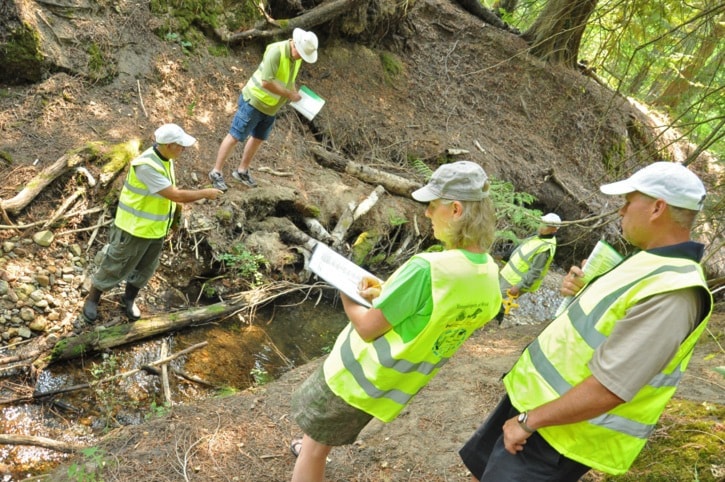 In many streams and creeks along Kootenay Lake's East Shore, spawning kokanee salmon have disappeared completely in recent years, but a new society is aiming to change that.
In many streams and creeks along Kootenay Lake's East Shore, spawning kokanee salmon have disappeared completely in recent years, but a new society is aiming to change that.
With the goal of remediating the tributaries that spill into Kootenay Lake, members of the Eastshore Freshwater Habitat Society (EFHS) have been training this summer through the Pacific Streamkeepers Federation, which offers education and support to similar groups.
"This is about stream stewardship, basically trying to take care of something you don't own," said Gerry Nellestijn, co-ordinator of the Salmo Watershed Streamkeepers Society, at a Riondel training session last week. "People are becoming aware of the need to help steward streams. It's not a government responsibility, it's a community responsibility."
The EFHS has over 160 members, about 10 of whom are active in training sessions. A few grew up in the Riondel area, and have noticed the depletion of Kokanee in East Shore streams, which used to be filled with spawning fish.
"As kids, we were up in there," said EFHS chair Mike Jeffery. "You could see the spawners."
Several factors have affected the Kokanee population, such as the construction of the Libby and Duncan dams — resulting in unnatural fluctuations in lake levels — and the earlier introduction of the freshwater mysis shrimp in 1949, which created "a very productive Kokanee fishery in the 1960s and 1970s," according to www.syilx.org. But those benefits didn't last.
"They thought they would be beneficial to the kokanee, but it turned out they competed," Jeffery said.
And more recently, kokanee in a few Kootenay Lake spawning channels were found to be infected with the infectious hematopoietic necrosis virus (IHNV), with spawning numbers dropping to about 200,000 in 2013, the lowest since records began to be kept in the 1960s.
"We're concerned because kokanee are not only a sport fish, they're a keystone species in the whole Kootenay Lake food web," Ministry of Forest, Lands and Resource Operations senior fisheries biologist Jeff Burrows told the Nelson Star in January. "So many animals rely on Kokanee: bears, osprey, even mallard ducks eat the eggs. They're important."
Research into the virus is ongoing, but it provides the EFHS with a good reason to keep working toward its goal of restoring watershed to their natural state and start restocking the population. The group isn't yet certified with Pacific Streamkeepers, but already has its sights set on Crawford Bay's Crawford Creek and Tam O'Shatner Creek, five kilometres north of Riondel.
In addition to restoring those creeks, the EFHS also plans to do some extensive mapping and analysis of all waterways on the east side of Kootenay Lake, from Murphy Creek at the north end (just south of Johnsons Landing) to Sirdar in the south, and back up the west side to Drewry Point, across the lake between Boswell and Sanca.
The active EFHS members have already been hard at work this year, and their activities have included a session with the Central Kootenay Invasive Plant Committee that showed how to identify things like zebra mussels, and last week's two-day workshop with Nellestijn, who went through a few of the 12 modules in the Pacific Streamkeepers curriculum, which taught about the technical part of stream characteristics and offered insight into stream health. In coming weeks, the members will have a workshop with a biologist and another workshop on invasive aquatics.
With training and certification backing them up, the society's aim is to work with government ministries — mainly forestry, but also the Ministry of Transportation and Infrastructure in cases where, for example, creeks may erode and undermine roadways — to make the area's waterways sustainable in the future.
"Communities have a lot of skill in them, and a lot of enthusiasm," Nellestijn said. "They see a direct responsibility."
For more information on the Eastshore Freshwater Habitat Society, visit www.eastshorefreshwaterhabitatsociety.org.
